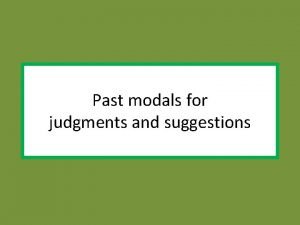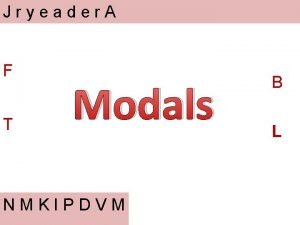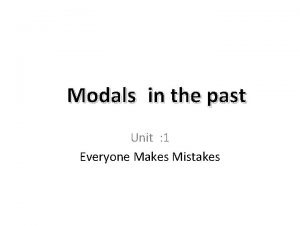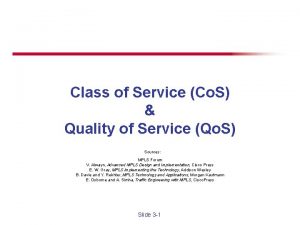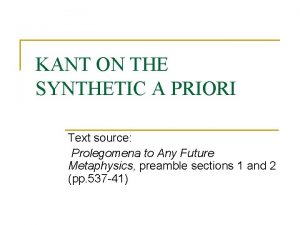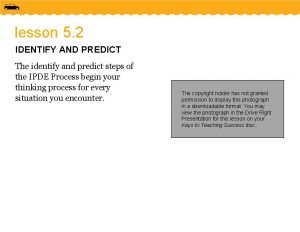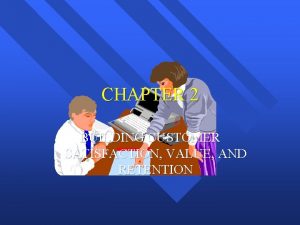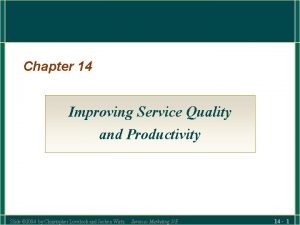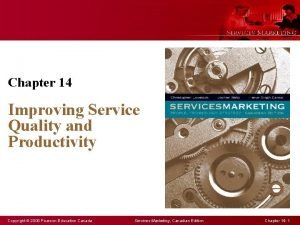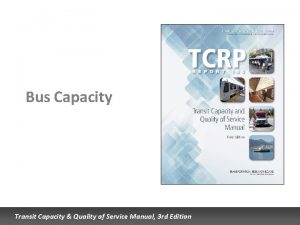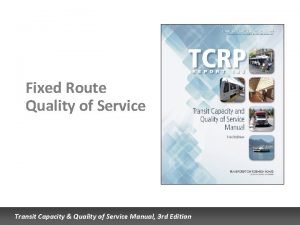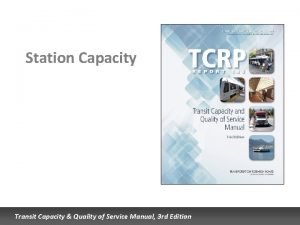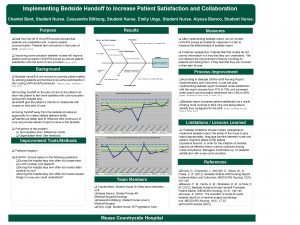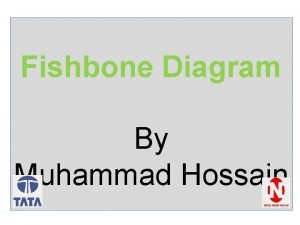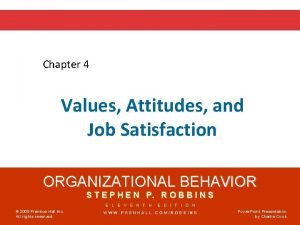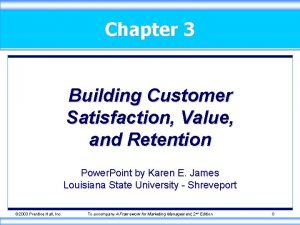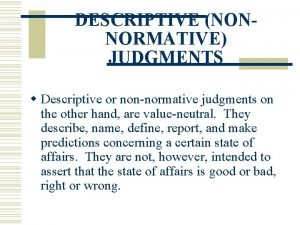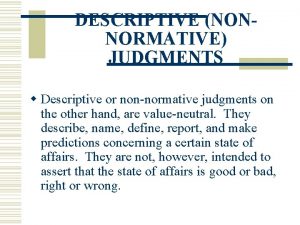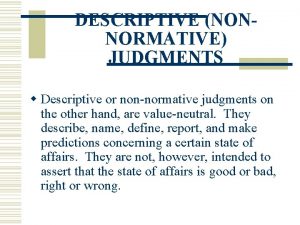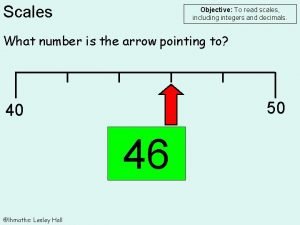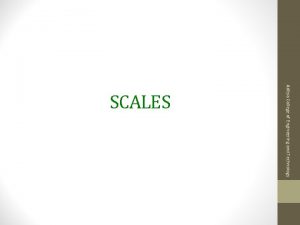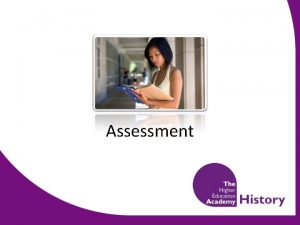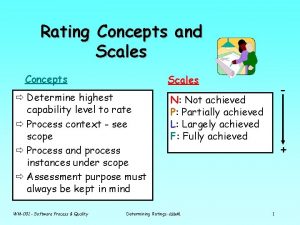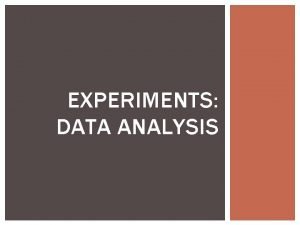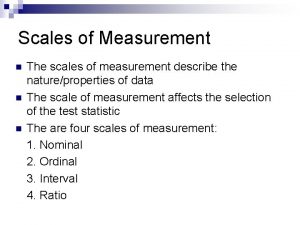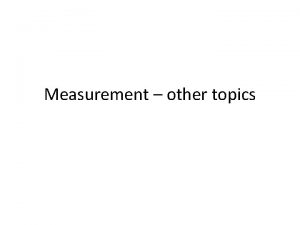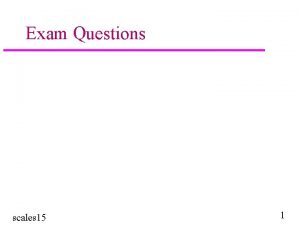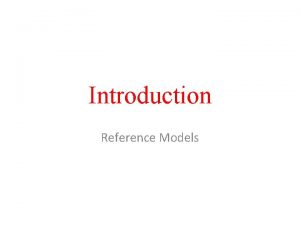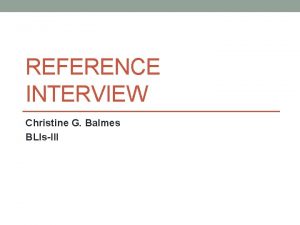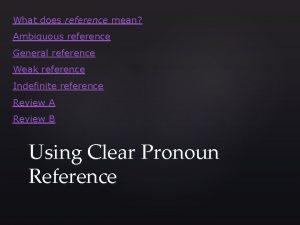Reference Scales of Service Quality and Satisfaction Judgments




























- Slides: 28

Reference Scales of Service Quality and Satisfaction Judgments: A Reconsideration and Research Agenda Stephen L. Vargo University of Maryland

Outline of Presentation • Implied Reference Scales--Models and Issues • Partial results of three Studies of Reference Scale Organization • Research Implications and Directions

The Research Domain • Reference Scale = The mental “ruler” used in making judgments about marketing phenomena (e. g. , service encounters) • Satisfaction • Service-quality • Components: • Standard: A point on the reference scale that the consumer uses in the comparison of external stimuli • Categories (zones, latitudes): Similarly valenced ranges (latitudes) on a reference scale • associated with common (or similar) evaluative judgments (e. g. , good or bad).

Implied Reference Scales a. Disconfirmation model (single standard) Positive Disconfirmation Negative Disconfirmation (-) (+) Implied Positive Latitude Implied Negative Latitude Expected b. Zone of tolerance model (multiple standard, bounded range) Negative Disconfirmation Latitude of acceptance (Positive Disconfirmation ? ) (-) (+) Implied Negative Zone of Tolerance Minimum Tolerable Standard Desired Standard

Some Problems with Disconfirmation and Zone Models • What is appropriate single standard • e. g. expected, desired, deserved, or adequate performance (Bolton and Drew 1991; Boulding et al. 1993; Spreng and Mackoy 1996) • Nature of Standard (and therefore comparison) • e. g. , “vector attribute” or “ideal point” (Teas 1993) • Expectations and perceptions not independent • “we see what we expect to see” (Pieters, Koelemeijer, and Roest 1996)

Implied Reference Scales (2) Latitude model of social judgment theory (multiple standard, anchor-based) Latitude of objectionability Latitude of acceptance (-) Latitude of objectionability (+) Most Objectionable Most acceptable Latitude of Noncommitment

Reference Scale Types and Issues • Major reference scale models • Single-standard comparison models—e. g. , disconfirmation model (Oliver 1980 ) • Boundary-driven, zone models—e. g. , zone of tolerance model (Parasuraman et al. 1994 ; Woodruff, et al 1983 ) • Anchor-based, latitude models—e. g. , latitude of acceptance (Social judgment theory) (Anderson 1973; Miller 1977 ) • Issues • Nature of standards--boundaries vs. anchors • Related to vector attributes vs. “ideal points” • Relative role of alternative standards • Predicted expectations, normative expectations (should, deserve) desire, minimum tolerable • Dynamics of reference scales under varying conditions • e. g. , prior positive or negative evaluation • e. g. , changes under hi and low involvement conditions

Study 1: Summary of Hypotheses • Consumers differentiate among standards—i. e. , standards play different roles • Standards are not equivalent to latitude boundaries. • Standards consistently associated specific latitudes. • Existence of “hyperservice”—positively rated attribute dimension is evaluated “unacceptable” • Positive and negative behavioral intentions associated with positive and negative latitudes, respectively. • No behavioral intensions associated with neutral latitude.

“Own Categories” Sample Statements: Friendliness • The waitperson tells you that you were wonderful customers (11). • The waitperson writes a personal note of thanks on the check (11). • The waitperson says: "Let me know when you have made up your mind" (6). • The waitperson touches you when talking to you (6). • The waitperson asks a lot of personal questions (6). • The waitperson points out the least expensive items on the menu (6). • The waitperson comments that your clothes are out of fashion (1). • The waitperson swears at you (1). Notes: Number (1 -11) equals median placement in pre-test; Approximately 50 total statements. Also used serving response-time—separate instrument

Category Cards: Waitperson Friendliness a. Waitperson Friendliness 1 Extremely Friendly 2 3 4 5 6 7 8 9 10 11 Extremely Unfriendly b. Serving Response-time 1 Extremely Slow 2 3 4 5 6 7 8 11 Extremely Fast

“Own Categories” Procedures (1) • Respondents given scenario • Lunch with acquaintance in new, unknown family restaurant • Appearance, prices, quantity and quality of food were defined as “as expected” • Asked to sort statements about a dimension (e. g. , friendliness, serving time ) according to similarity • Asked to identify: • Stack which represents most acceptable service level • All other stacks that represent acceptable service levels. • Stack that represents most undesirable service level • All other stacks that represent unacceptable service levels.

“Own Categories” Procedures (2) • Asked to identify • Stacks that represent the service levels they would expect, desire, deserve, find minimally tolerable • Stacks they would associate with various behavioral intentions: • • Positive and negative word-of-mouth (tell friends) Leave Complain Repeat patronage

Average Reference Scale Organization a. Waitperson Friendliness Noncommitment Acceptance Objectionability (Hyperservice) (-) (+) Most Objectionable Minimum Tolerable Deserved Expected Most Acceptable Desired b. Serving Response Time Noncommitment Acceptance Objectionability (Hyperservice) (-) (+) Most Objectionable Minimum Tolerable Deserved Expected Most Acceptable Desired

Research Findings: Placement of Standards and Behavioral Intentions • “Expected” (Expect/Deserve) and “Desired” (Desire/Most acceptable) service standards associated with LA • Do not serve as boundaries • Minimum tolerable associated with LNC • not lower bound of LA • Strong evidence of “hyperservice” • Negative behavioral intentions associated with LO • Positive behavioral intentions associated with LA

Study 2: Focus Group • Purpose • Elaboration and enrichment of quantitative study • Exploratory • Approach • Think about and discuss good and bad restaurant experiences • Think about and discuss meaning of standards (e. g. , desired, ideal, expected, etc. ) • Place standards on two “rulers”—acceptable/unacceptable & friendly/unfriendly—and discuss • Watch video employing subset of statements from card sort • List and number behaviors • Position numbers on rulers (friendliness and acceptability/unacceptability) • Discuss likely responses to behaviors

Study 2: Focus Group: Outcomes • Fairly consistent ordering of standards • Some tendency to equate expected/deserved & desired/ideal • Tendency to group—stack (or “would have stacked if I knew I could”)--behaviors • A lot of support (verbal & on scale) for “hyperservice” • e. g. , flirting is extremely friendly, but unacceptable • Some evidence of different RS organ. Under different conditions • Importance (involvement) • Previous evaluation/relationship

a. Attribute Dimension Typical Mapping of Reference Scales Minimum Tolerable 16 17 Extremely Unfriendly 6 4 11 12 7 9 Expected & Deserved 2 13 1 15 8 Ideal Desired 10 5 Extremely 14 3 Friendly a. Evaluative Dimension 15 14 7 17 Extremely Unacceptable # 6 16 4 13 12 9 11 2 8 = Respondent-observed restaurant behavior from video Minimum Tolerable 1 Expected & Deserved Desired Ideal 10 5 3 #15 = waitperson gave phone # #14 = waitperson sat down when friend left table Extremely Acceptable

Study 3: Experiment • Purpose • Investigate impact of relationship/branding on reference scales • Differences in reference scales for restaurant with prior positive brand evaluation vs. new restaurant • Hypotheses--With prior, positive brand relationship: • • Decreased latitude of objectionability Increased latitude of non-commitment No change in latitude of acceptance Shift of positive BI from LA only to LA and LNC • Method • “Electronic” Card sort • “Branded” scenario assigned to half the respondents • Restaurant is new but recognize brand as part of favorite chain • Outcomes • Hypotheses generally supported (significance and trends) • Both LA and LO decreased • BI associate with both LA and LNC for Branded condition

Study 3: Comparison of Unbranded and Branded Reference Scales Tests of Mean Differences Among Latitude Measures Measure Mean (Branded) Mean (unbrand ed) Difference t-value p Sig Latitude of rejection (size) 3. 00 4. 06 -1. 06 -2. 45 0. 017 Y Latitude of acceptance (size) 3. 07 4. 11 -1. 04 -2. 25 0. 027 Y Latitude of non-commit. (size) 4. 32 2. 17 2. 15 2. 73 0. 008 Y Density of lat. of accept 12. 68 14. 86 -2. 17 -1. 15 0. 252 N Density of lat. of object 16. 44 22. 49 -6. 05 -2. 72 0. 008 Y Density of lat. of non-commit 25. 88 17. 66 8. 22 2. 38 0. 020 Y Minimum tolerable position 5. 00 0. 00 1. 00 N

Study 3: Comparison of Behavioral Intentions Frequency Distributions Of Behavioral Intentions By Latitude Variable Latitude Branded Freq RETURN Acceptability Unbranded Percent Freq Χ 2 df p<. 05 Percent 63 62. 38 71 78. 89 Objectionability 4 3. 96 6 6. 67 Noncommitment 34 33. 66 13 14. 44 9. 96 2 yes

Extensions and Research Agenda • Synthesis • Simultaneous influence of multiple standards • Sorting out the “latitudes” and “zones” in marketing literature • Adds depth to Social Judgment model • Role of minimum tolerable—”adaptation level” • Explanation of Satisfiers and Dissatisfiers • Distributions of expectations, desires • “Six Sigma” • Other evaluative reference scales—price • International Issues • Cross cultural differences in reference scales • Reference scale as index of acculturation

Latitude Relationships Latitude of Non-Acceptability Latitude of Objectionability (intolerance) Latitude of Tolerance Latitude of L of N Non- commitment Acceptance (indifference) L of O (-) Composite Latitudes Primary Latitudes (+) Hyperactivity Latitude Anchors

Latitude Profiles of Service Dimensions

Evaluative Distributions Distribution of objectionability Distribution of Desirability Distribution of Expectations (-) Distribution of objectionability (+) Most Objectionable Expected Desired Latitude of Noncommitment Partially based on Rust, Roland T. et al, (1999) “What You Don’t Know About Customer-Perceived Quality: The Role of Customer Expectation Distributions, Marketing Science” 18 (1), 77 -92.

Implications of Distributions Distribution of Expectations Distribution of Desirability (+) D Desire “Relationship” ↑as D ↓ or, more precisely, Expect Ideal Relationship = Distribution of expectations within distributions of desirability Six Sigma = 99. 9998 % of performance within Latitude of Acceptability

Other Directions • Evaluative reference scales in price research • “altitude of price acceptance” • Cultural Issues • Cultural differences in reference scales • Satisfiers and dissatisfiers as bases for local vs. global • Reference scales as indices of acculturation

Management Implications • Managing the service-encounter • Not sufficient to know what consumer wants • Must know what consumer finds objectionable • Too much service (hyperservice”) may be more harmful than too little • Managing the evaluation process • Competitive advantage through expectations management • Can not manage positive latitudes only • May be more important to manage LO and LNC

Implied Management Strategies
 Modals of suggestion
Modals of suggestion Past modals for judgments and suggestions
Past modals for judgments and suggestions Everyone make or makes
Everyone make or makes Class of service vs quality of service
Class of service vs quality of service Synthetic a priori judgments
Synthetic a priori judgments Making driving judgments involves
Making driving judgments involves Reference node and non reference node
Reference node and non reference node Reference node and non reference node
Reference node and non reference node Perform quality assurance
Perform quality assurance Concept of quality assurance
Concept of quality assurance Customer satisfaction value and retention
Customer satisfaction value and retention Improving service quality and productivity
Improving service quality and productivity Service quality and productivity
Service quality and productivity Transit capacity and quality of service manual
Transit capacity and quality of service manual Transit capacity and quality of service manual
Transit capacity and quality of service manual Transit capacity and quality of service manual
Transit capacity and quality of service manual Project quality management pmp
Project quality management pmp Quality metrics pmp
Quality metrics pmp Quality improvement vs quality assurance
Quality improvement vs quality assurance Quality improvement vs quality assurance
Quality improvement vs quality assurance Quality gurus and their contribution
Quality gurus and their contribution Quality is free
Quality is free What is tqm
What is tqm X theory manager
X theory manager Bedside shift report and patient satisfaction
Bedside shift report and patient satisfaction 6m's
6m's Values attitudes and job satisfaction
Values attitudes and job satisfaction Customer satisfaction value and retention
Customer satisfaction value and retention What is customer value satisfaction and loyalty
What is customer value satisfaction and loyalty
